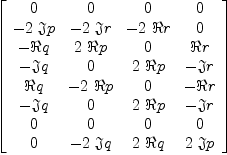|
|
|
last edited 13 years ago by Bill Page |
Edit detail for SandBoxHermitianIsomorphisms revision 6 of 7
| 1 2 3 4 5 6 7 | ||
|
Editor: Bill Page
Time: 2011/06/26 16:09:30 GMT-7 |
||
| Note: documentation | ||
added: A complex vector ℂ-space $V$ possesses many different hermitian isomorphisms $h^\dagger=h \in iso(V,V^\dagger)$. In quantum mechanics a given operator $\rho \in End(V)$ may be said to be $h$-hermitian if $$ \rho^\dagger \circ h = h \circ \rho $$ changed: -p:Complex Fraction Polynomial Integer:=complex(ℜp,𝔍p) -q:Complex Fraction Polynomial Integer:=complex(ℜq,𝔍q) -r:Complex Fraction Polynomial Integer:=complex(ℜr,𝔍r) -t:Complex Fraction Polynomial Integer:=complex(ℜt,0) -ρ:=matrix [[t/2+p,q],[r,t/2-p]] ℂ:=Complex Fraction Polynomial Integer -- dagger htranspose(h)==map(x+->conjugate(x),transpose h) )expose MCALCFN \end{axiom} Theorem The necessary conditions for an operator $ρ$ to possess hermitean isomorphism $h$ is that $trace ρ \in ℝ$ and $det ρ \in ℝ$. Two-Dimensions \begin{axiom} p:ℂ:=complex(ℜp,𝔍p) q:ℂ:=complex(ℜq,𝔍q) r:ℂ:=complex(ℜr,𝔍r) t:ℂ:=complex(ℜt,0) ρ:Matrix ℂ := matrix [[t/2+p,q],[r,t/2-p]] added: test(p^2+r*q=(1/4)*t^2-d) removed: -test(p^2+r*q=(1/4)*t^2-d) added: Given an operator $ρ \in End V$, one must find the tensor $H=0$ for unknown manifold of hermitian isomorphisms $h$. changed: -h:Matrix Complex Polynomial Integer:=matrix [[a,complex(b,c)],[complex(b,-c),e]] -htranspose(h)==map(x+->conjugate(x),transpose h) h:Matrix ℂ:=matrix [[a,complex(b,c)],[complex(b,-c),e]] added: H:=htranspose(ρ)*h-h*ρ added: We wish to find expressions for $h$ in terms of the components of $ρ$. To do this we will determine how the components of $H$ depend on the components of $h$. changed: -H:=htranspose(ρ)*h-h*ρ -Hlist:=concat(H::List List ?) -Hreal:=removeDuplicates(select(x+->(x~=0),concat(map(x+->real x, Hlist),map(x+->imag x, Hlist)))) -)expose MCALCFN -H1:=jacobian(Hreal,[a,b,c,e]::List Symbol) J:=jacobian(concat( map(x+->[real x, imag x], concat(H::List List ?)) ), [a,b,c,e]::List Symbol) added: The null space (kernel) of the Jacobian changed: -s1:=solve(determinant subMatrix(H1,2,5,1,4),ℜr) -H2:=map(x+->eval(x,s1),H1) -N:=nullSpace(H2) -H2*(c*N(1)+e*N(2)) -s2:=map((x,y)+->x=y,[a,b,c,e],c*N.1+e*N.2) -h1:=map(x+->eval(x,s2),h) -map(x+->eval(x,s1),htranspose(ρ)*h1-h1*ρ) N:=nullSpace(map(x+->eval(x,s0),J)) added: gives the general solution to the problem. \begin{axiom} s1:=map((x,y)+->x=y,[a,b,c,e],c*N.1+e*N.2) map(x+->eval(x,concat(s0,s1)),H) \end{axiom}
A complex vector ℂ-space ![]() possesses many different hermitian isomorphisms
possesses many different hermitian isomorphisms
![]() . In quantum mechanics a given operator
. In quantum mechanics a given operator
![]() may be said to be
may be said to be ![]() -hermitian if
-hermitian if
axiom
ℂ:=Complex Fraction Polynomial Integer
| (1) |
Type: Type
axiom
-- dagger htranspose(h)==map(x+->conjugate(x),transpose h)
Type: Void
axiom
)expose MCALCFN
MultiVariableCalculusFunctions is now explicitly exposed in frame initial
Theorem
The necessary conditions for an operator ![]() to possess hermitean isomorphism
to possess hermitean isomorphism
![]() is that
is that ![]() and
and ![]() .
.
Two-Dimensions
axiom
p:ℂ:=complex(ℜp,𝔍p)
| (2) |
Type: Complex(Fraction(Polynomial(Integer)))
axiom
q:ℂ:=complex(ℜq,𝔍q)
| (3) |
Type: Complex(Fraction(Polynomial(Integer)))
axiom
r:ℂ:=complex(ℜr,𝔍r)
| (4) |
Type: Complex(Fraction(Polynomial(Integer)))
axiom
t:ℂ:=complex(ℜt,0)
| (5) |
Type: Complex(Fraction(Polynomial(Integer)))
axiom
ρ:Matrix ℂ := matrix [[t/2+p,q], [r, t/2-p]]
| (6) |
Type: Matrix(Complex(Fraction(Polynomial(Integer))))
axiom
trace ρ
| (7) |
Type: Complex(Fraction(Polynomial(Integer)))
axiom
d:=determinant ρ
| (8) |
Type: Complex(Fraction(Polynomial(Integer)))
axiom
test(p^2+r*q=(1/4)*t^2-d)
| (9) |
Type: Boolean
axiom
s0:=solve(imag d,ℜr)
| (10) |
Type: List(Equation(Fraction(Polynomial(Integer))))
axiom
eval(trace(ρ*ρ),s0)
| (11) |
Type: Fraction(Polynomial(Complex(Integer)))
Given an operator ![]() , one must find the tensor
, one must find the tensor ![]() for unknown manifold of hermitian isomorphisms
for unknown manifold of hermitian isomorphisms ![]() .
.
axiom
h:Matrix ℂ:=matrix [[a,complex(b, c)], [complex(b, -c), e]]
| (12) |
Type: Matrix(Complex(Fraction(Polynomial(Integer))))
axiom
test(h = htranspose h)
axiom
Compiling function htranspose with type Matrix(Complex(Fraction(
Polynomial(Integer)))) -> Matrix(Complex(Fraction(Polynomial(
Integer))))| (13) |
Type: Boolean
axiom
H:=htranspose(ρ)*h-h*ρ
| (14) |
Type: Matrix(Complex(Fraction(Polynomial(Integer))))
We wish to find expressions for ![]() in terms of the components of
in terms of the components of
![]() . To do this we will determine how the components of
. To do this we will determine how the components of ![]() depend
on the components of
depend
on the components of ![]() .
.
axiom
J:=jacobian(concat( map(x+->[real x,imag x], concat(H::List List ?)) ), [a, b, c, e]::List Symbol)
 | (15) |
Type: Matrix(Fraction(Polynomial(Integer)))
The null space (kernel) of the Jacobian
axiom
N:=nullSpace(map(x+->eval(x,s0), J))
| (16) |
Type: List(Vector(Fraction(Polynomial(Integer))))
gives the general solution to the problem.
axiom
s1:=map((x,y)+->x=y, [a, b, c, e], c*N.1+e*N.2)
| (17) |
Type: List(Equation(Fraction(Polynomial(Integer))))
axiom
map(x+->eval(x,concat(s0, s1)), H)
| (18) |
Type: Matrix(Fraction(Polynomial(Complex(Integer))))